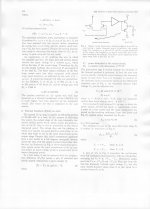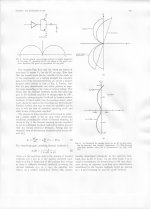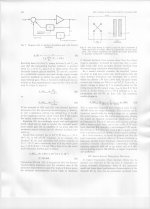I would think that at low frequencies with enough feedback the voltage at the point of connection would be essentially perfect, like it is on an AC calibrator. However at some frequency that won't work. Either you get instability from the reactive elements in the cables adding up or the wavelengths are too short and your sense point will be out of phase with the signal source. In the world of microwave you use remote sensing with a power sensor to level a source. That has little relevancy to audio frequencies.
Cello used remote sensing. I think some Japanese "over the top" designs from the 80's also did. They all needed specific cables to work.
Cello used remote sensing. I think some Japanese "over the top" designs from the 80's also did. They all needed specific cables to work.
Since we seem to be back to cables again I have a question. Is there any advantage to using a twisted pair plus ground wire if needed in a power cable? Is there really any reason to worry about this before the power supply as the wires in the walls are either parallel wires in a metal conduit or parallel wires in Romex type cable? Just wondering if this helps in anyway before the power supply and any PSRR?
I'm personally glad they're shutting down coal fired generation here in Appalachia; natural gas, hydro & wind power create a much more enjoyable CLEAN sound for me.
Nuclear power has an unreal harshness to it, don't you think? Not to mention that trashy co-generated industrial waste power... who wants to listen to THAT??
John L.
Nuclear power has an unreal harshness to it, don't you think? Not to mention that trashy co-generated industrial waste power... who wants to listen to THAT??
An externally hosted image should be here but it was not working when we last tested it.
John L.
Last edited:
Just to throw a wrench in the works let's reconsider the cable issue with a separate Kelvin connection for feedback to the amp.
Might make nice oscillators.
Since we seem to be back to cables again I have a question. Is there any advantage to using a twisted pair plus ground wire if needed in a power cable? Is there really any reason to worry about this before the power supply as the wires in the walls are either parallel wires in a metal conduit or parallel wires in Romex type cable? Just wondering if this helps in anyway before the power supply and any PSRR?
It couldn't hurt.
You would in theory keep interference at arms length away from the amplifier and RCA inputs.
Kenwood did that.
I know "Sigma Drive", at 2 or 3 meters of cable we might be able to end the phase vs delay controversy. With care I think the amp could be stablized.
To expand a little on the Bateman issue, there is no way to make a bridge that will give the right answer for complex impedance in the transmission line sense where the real and imaginary parts are orders of magnitude apart due to there being .001 wavelenghts of line. His bridge could no more work at 10kHz than an RF bridge could at 10MHz with 1cm of line. There is simply not enough energy lost in the loss mechanisms to resolve it from the energy stored.
Last edited:
Personally, I would do a first level of filtering out of muck at the plug end, then use a clean, interference resisting run of cable to the component, and finally use heavy duty filtering at the point where the cable is entering the box.Is there any advantage to using a twisted pair plus ground wire if needed in a power cable? Is there really any reason to worry about this before the power supply as the wires in the walls are either parallel wires in a metal conduit or parallel wires in Romex type cable? Just wondering if this helps in anyway before the power supply and any PSRR?
Have question: I have read somewhere in these annals John mentioning the thermal efficiency of discretes contributing to their linearity. I also read one of the lme type op amp in a TO can internally mounted on a ceramic substrate, AlN I presume, sounded better because of higher thermal efficiency. So why not just slap a TEC on the critical op amp? Again, for home use, the power consumption would be low, the amount dependant on the hot side heat sink. In the more extreme, I have recently packaged a laser with a total heat load ( ambient effective load included) of 2.3 W which will take the laser from 85 C to 22 C with 1% stability in 3 S. The system consumed about 36 W to drive this transient. With an ambient at 35 C it consumes under 3 W steady state. So why not run the op amps at a steady 15 C and use the high thermal mass of the op amp substrate to advantage? The substrate would not see the low wattage heat. I am assuming the heat produced is roughly twice the output wattage.
External Sensing
Hi Scott, amusingly enough I did this in the late 1980's and learned all about feedback phase margin in the process...amongst the bits and pieces of smoking speakers. I ended up limiting the BW to 250Hz and concentrating on subs. I still have the wicked JBL 18" 2245H-based 12ft3 sub (Keele design) which I mated to a QSC 1.2KW bridged amp. 120dB of output, with the 3dB point 18Hz. It was banished from the living room by my significant other and now resides in shame in the basement.

Howie
Howard Hoyt
CE - WXYC-FM 89.3
UNC Chapel Hill, NC
www.wxyc.org
Just to throw a wrench in the works let's reconsider the cable issue with a separate Kelvin connection for feedback to the amp.
Hi Scott, amusingly enough I did this in the late 1980's and learned all about feedback phase margin in the process...amongst the bits and pieces of smoking speakers. I ended up limiting the BW to 250Hz and concentrating on subs. I still have the wicked JBL 18" 2245H-based 12ft3 sub (Keele design) which I mated to a QSC 1.2KW bridged amp. 120dB of output, with the 3dB point 18Hz. It was banished from the living room by my significant other and now resides in shame in the basement.

Howie
Howard Hoyt
CE - WXYC-FM 89.3
UNC Chapel Hill, NC
www.wxyc.org
Have question: I have read somewhere in these annals John mentioning the thermal efficiency of discretes contributing to their linearity.
I preamp duty the trmperature swings are in the small fractions of a degree and besides the matching is much better on one substrate. If you stick with linearity as a measurable and quantifiable thing you would have a hard time proving that point.
In an older run of the subject, this was documented sufficiently enough. How did it surfaced again?
http://americas.kyocera.com/kai/semiparts/assets/pdf/MEblen_IMAPS_Thermal_ATW06.pdf
Good. Then why not test with 10MHz and ~3m cable? Doing the same at 100MHz and 1MHz would show the behaviour of the effect re loss/store energy. It would remain the issue of audibility of the scaled down effect at AF .
Scott, did you have progress with the simulation of TL using Mr. McCammon's model?
George
http://americas.kyocera.com/kai/semiparts/assets/pdf/MEblen_IMAPS_Thermal_ATW06.pdf
To expand a little on the Bateman issue, there is no way to make a bridge that will give the right answer for complex impedance in the transmission line sense where the real and imaginary parts are orders of magnitude apart due to there being .001 wavelenghts of line. His bridge could no more work at 10kHz than an RF bridge could at 10MHz with 1cm of line. There is simply not enough energy lost in the loss mechanisms to resolve it from the energy stored.
Good. Then why not test with 10MHz and ~3m cable? Doing the same at 100MHz and 1MHz would show the behaviour of the effect re loss/store energy. It would remain the issue of audibility of the scaled down effect at AF .
Scott, did you have progress with the simulation of TL using Mr. McCammon's model?
George
Yep..John do you know Julius Siksnius of Audire fame ....?
I remember going down to Julius shop in fountain Valley and listening to his ribbons while having one of his amps updated.
He had quite a few amps /pre,s over the years. A 3 foot tall heat sink and pure class A was one of them.
Giving a tube loving reviewer (dick olsher) a solid state device requires a leap of faith on your part that doesn't always work out to well...,.
He made some listenable decent products, just not SOTA
Is Julius still with us? BTW
Regards
David
I will have to read this , can't see on iPad even exploded. Scott, it has to do the thermal flux. In the laser world, the active regions are so small and flux so high we can't even reproduce it with a resistor, during mock ups to test the thermal management. As in the above paper, at high data rates these effects can be ignored W.R.T. the linearity of a modulated current ( direct modulation that is). I suspect in the audio frequency range they might become relevant. One would have to know the physical sizes if the active regions, materials, etc. This is a modeling problem for COMSOL , not Solidworks Simulation. There is also a thermal impeadance componant at the internal boundaries of lasers as well as the die to mount region. It is a thermal reflection best described by the wave equation. In real life you might have experienced this. If you have ever had a metal rod or piece on a grinding wheel and then quenched it only to have the end your holding suddenly get extremely hot. At fist this violate the laws of thermal dynamics, but can be explained by the wave -impeadance model. The question is what the the extent of the thermal componant, and what frequency does it become moot. Also, if relavent, could this be a reason why different opamps sound different? Based on size of active regions, thermal flux, etc.
If anyone would like to try a first order test, I could provide a couple do TEC's , heat sinks and thermistors. Though I think you could suffice with out a control loop to drive the TEC, just drive it with a fixed voltage.
If anyone would like to try a first order test, I could provide a couple do TEC's , heat sinks and thermistors. Though I think you could suffice with out a control loop to drive the TEC, just drive it with a fixed voltage.
Last edited:
I remember going down to Julius shop in fountain Valley and listening to his ribbons while having one of his amps updated.
He had quite a few amps /pre,s over the years. A 3 foot tall heat sink and pure class A was one of them.
Giving a tube loving reviewer (dick olsher) a solid state device requires a leap of faith on your part that doesn't always work out to well...,.
He made some listenable decent products, just not SOTA
Is Julius still with us? BTW
Regards
David
Last I know , yes he's still with us and i was always of the belief his stuff was more than alright , well for the time ....
Solomon's calculations:
This is tired old school stuff problem solved move on. You can do the wrong thing and get burnt so what?
Last edited:
- Status
- Not open for further replies.
- Home
- Member Areas
- The Lounge
- John Curl's Blowtorch preamplifier part II


